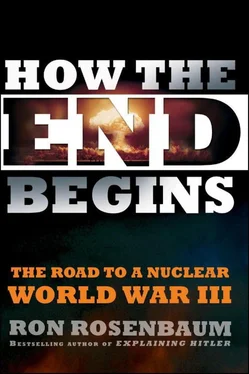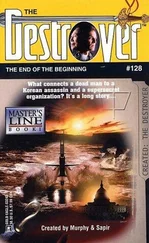Note the verb: wage deterrence. “Waging” usually suggests physical armed combat, rockets’ red glare, bombs bursting in air, at the very least a finger pushing a button or twisting a key. But with this kind of waging, we’re really not lifting a finger, so much as—metaphorically, conceptually, doctrinally—wagging a finger: don’t you dare, or else. We’re waging war conceptually every moment we wage deterrence. Is waging deterrence, threatening genocide, different from waging wars? In some ways yes, we’re waging war with a future, notional enemy. To oversimplify: a man who puts a gun to your head but doesn’t pull the trigger is still using the gun.
Oh and yes, that Zero thing. Here’s what the nation’s nuclear commander had to say about the commander-in-chief’s vision of Zero: “Regardless of whether you believe the idea that a nuclear weapons–free world is a possibility,” General Chilton said dismissively, clearly indicating he was not one of those tie-dyed dreamers, “the reality is that nuclear weapons will be with us in the foreseeable future.”
Again, an interesting choice of words, “foreseeable.” The commander-in-chief had explicitly said he wanted to make it our national goal to make a nuclear-free world foreseeable. But the president’s top nuclear general does not foresee it in the foreseeable future, and had nothing good to say about the value of making it foreseeable. He was all about making nuclear deterrence even more useful. Preserving, modernizing, “tailoring,” sophisticating, reshaping, extending, enhancing deterrence—deterrence 2.0. That’s what this conference was about. Getting the most out of our nukes, not getting rid of them. A common theme of the conference was that it was time—despite what some might say—to stop being ashamed of nuclear weapons and nuclear deterrence. They saved lives. Say it loud: We got nukes and we’re proud.
It couldn’t have been, in a coded low-key way, a more dramatic repudiation of the president.
General Chilton had already clashed openly with the president over a nuclear issue earlier that year. [87]During the campaign, Obama had pledged “to change a situation in which our nuclear missiles are on hair-trigger alert.” In January 2009, shortly before Obama’s inauguration, General Chilton made a point of taking aim at that idea in a speech in Orlando in which he denied any of our weapons were on hair-trigger alert. “It is misleading to use the term ‘hair-trigger’ when describing the U.S. arsenal,” which he said remains safe from accidental or unauthorized launch. “It conjures a drawn weapon in the hands of somebody,” said the general, speaking at a two-day conference on air warfare. “And their fingers on the trigger. And you’re worried they might sneeze, because it is so sensitive.” The reality of our alert posture today, he said, “is that the weapon is in the holster.” He explained that “it takes two people to open those locks,” and “they can’t do it without authenticated orders from the President of the United States.” [88]
General Chilton was cleverly redefining the semantic argument over what was, and what wasn’t, “hair-trigger.” He was saying that the guns can’t be fired instantly without deliberation and proper orders. But the issue over the wording for our alert posture (“hair-trigger,” “launch on warning,” “launch on alert”) goes to the question of whether, in the twenty years since a Cold War–kind of deadly hostility ended, we and the former Soviets have ever realistically de-alerted the land-based missile forces that still face off against each other.
At her confirmation hearing, Secretary of State designate Hillary Clinton said the incoming administration wants to end the Cold War practice of keeping intercontinental ballistic missiles ready for launch “at a moment’s notice,” though she added the proviso that this de-alerting must be done “in a mutual and credible manner.” [89]
According to the Washington Post account of Clinton’s testimony, calls for previous administrations to take weapons off the hair-trigger alert “have failed because the Air Force thought its missile launch officers would lose their edge if they no longer did alert duty.”
Sometimes it’s too easy to see the absurdity in such pronouncements. Duty officers need to put the world in peril, need to maintain hair-trigger alert postures, so they will keep their edge? In other words, we need to put the world in peril to do what a cup of black coffee could do. Maybe what the Pentagon needs for duty officers is better baristas—but that’s one worthy of the Catch-22 file.
How about de-alerting nukes so duty officers won’t have to be on edge, as if on edge is the main thing you want your officer to be, tremors and spasms of nervousness shaking his being as he tries to decide whether a blip on the radar screen requires an “assessment conference.”
The fact is we have de-targeted our missiles, but in a way that’s easy to re-target: we have just removed, say, the Moscow-specific GPS codes from the interior of the missile software. [90]But the codes still exist on the missile base computers and just need a nanosecond burst of code to aim the missile again, according to Bruce Blair. So de-alerting is a sham, and so is de-operationalizing missiles. What that means is that a missile is separated from its warhead. But in practice, the warheads are often stored on the same base, where they can be reassembled fast.
Worse than sham de-targeting, and sham dismantling, though, is that we’ve never de-alerted. Our alert time is generally thought to be fifteen minutes or less because that is the window between the moment radars or satellites pick up the launch by an offshore nuclear submarine, and detonations on or above coastal cities like Washington and New York. We have fifteen minutes to decide whether—on the basis of radar and satellite traces—to pull the trigger. If that’s not hair-trigger, it doesn’t exactly leave much time for contemplation. In some cases it could even allow us to justify a launch upon the simultaneous confirmation of what the Air Force likes to call, probably because it sounds so super-scientific, “dual phenomenology.” [91]Which just means two sources of signals: radar and satellite. They are the two types of technology that are supposed to be able to tell us whether the “missiles” being tracked on an attacking path toward us are real or not. Officially, our policy is called “launch under attack.” But, our de facto policy with only fifteen minutes warning time is “launch on warning,” since the fifteen-minute warning window will put us in a “use it or lose it” situation: we need to fire those missiles out of their silos before they are destroyed while they are still in them. Thus we have a policy in which a launch can be triggered by pixels on a screen rather than unmistakable real missiles.
This hair-trigger issue provokes hair-trigger tempers in the Pentagon, as General Chilton’s extraordinary decision to discuss launch policy in public in order to rebuke the president demonstrates. To sum up a long debate, it all depends on what you mean by hair-trigger. If you think people using the phrase are attributing to us the ability for something like the instantaneous firing of a gun that already has the safety off and the trigger cocked, then our nuclear posture is not hair-trigger. But if you think the ability to get our missiles off with less than fifteen minutes notice on potentially ambiguous or unconfirmed warning data in such a hectically compressed interval that you might be justified in using the phrase hair-trigger for it, I wouldn’t disagree.
General Chilton’s performance at the conference was one clue that it was one giant pushback against Obama’s Zero. But so was the essay I found in Strategic Quarterly, the STRATCOM journal handed out to everyone who registered in Omaha. It was written by the first panel’s moderator, Dr. Keith Payne.
Читать дальше











